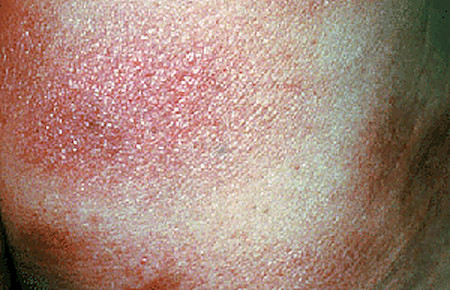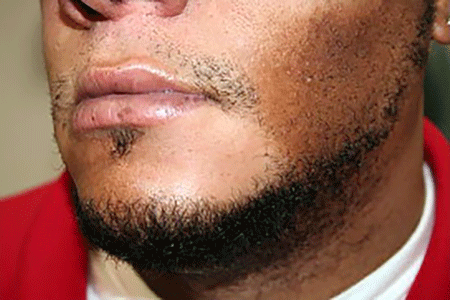Cutaneous T-cell lymphoma: Symptoms
Early in its growth, the cancer may not cause any symptoms like itching or feeling tired
Symptoms tend to develop later. Signs like a rash or light spots on your skin tend to develop before symptoms.

Itchy skin is a common symptom of cutaneous T-cell lymphoma
Studies show that more than half the people who have cutaneous T-cell lymphoma develop itchy skin. Itchy skin tends to be more common if you have a:
More advanced stage of cutaneous T-cell lymphoma
Type of cutaneous T-cell lymphoma called Sézary (Sez-zah-ree) syndrome
The itch can be intense. As the cancer worsens, the itch can make it hard to sleep.
Other symptoms of cutaneous T-cell lymphoma include fever, chills, weight loss, and feeling tired. Not everyone develops these symptoms.
What are the signs of cutaneous T-cell lymphoma?
There are several types of cutaneous T-cell lymphoma, also known as CTCL. What you see on your skin (signs) tends to vary with the:
Type of cutaneous T-cell lymphoma you have
Stage of the cancer
Signs of cutaneous T-cell lymphoma that can appear on the skin
The following cutaneous T-cell lymphoma pictures show you how these cancers can show up on the skin. Many of these pictures show the most common type, which is mycosis fungoides (my-co-sis fuhng-goi-des).
Rash or skin looks sunburned (mycosis fungoides)
When it begins, mycosis fungoides often looks like a rash or sunburn. This rash usually appears on skin that gets little sun like the upper thigh, buttocks, belly, or groin. The rash can last for months or years. On lighter skin tones, the area often looks red or pink. People with darker skin tones tend to see a brown or purple rash.

Scaly patches or light spots on the skin (mycosis fungoides)
If mycosis fungoides progresses, the rash can turn into flat, scaly, reddish patches (A). These patches may be mistaken for another skin disease like eczema or psoriasis. Instead of having scaly patches, some people see light spots (B). Light spots are more common in people who have darker skin tones, children, and teenagers.

Plaques on the skin (mycosis fungoides)
If the cancer progresses, the flat patches turn into plaques, which are raised patches. The plaques are often itchy. In darker skin tones, plaques tend to be dark brown, grayish, or purple. People who have lighter skin tones tend to have red or pink plaques.

Tumors on the skin
Tumors are a sign of advanced cancer. You can develop tumors where you have plaques on your skin or on skin without signs of cutaneous T-cell lymphoma. Some patients have patches, plaques, and tumors (A). In darker skin tones (B), the tumors may be reddish in color to purple.

Darker and lighter areas
People who have darker skin tones may develop scaly, raised patches that are darker than their natural skin tone and lose skin color in other areas, as shown here.

Peeling skin, rash, or intense itch (Sézary syndrome)
An advanced cancer, Sézary syndrome can cause peeling skin, a rash over most of the body, and tumors on the skin. The skin can feel hot, sore, or intensely itchy. People with lighter skin tones often develop a red rash. On darker skin tones, the rash may be less noticeable.

Hair loss
Different types of cutaneous T-cell lymphoma can cause hair loss, which may occur anywhere on the body. This patient developed hair loss where a light patch developed on his chin. Hair often regrows after the cancer is treated.

Other signs that can show up on the skin
The different types of cutaneous T-cell lymphoma can also cause:
A skin infection: Signs of a skin infection include widespread skin discoloration, hot spots on your skin, painful burning, swollen skin, pus draining from a wound, or an oozing sore. If you see any of these on your skin, get medical care. A skin infection can be serious in people who have cutaneous T-cell lymphoma.
Thickening of the skin on the palms and soles: This skin in these areas can also split, causing deep, painful cracks in the skin.
Slack skin: Developing slowly, this eventually causes noticeable loose, hanging skin that doesn’t spring back. Slack skin usually appears in the armpit or groin.
Swollen lymph nodes: This doesn’t always mean that the cancer has spread to the lymph nodes. Only in the most advanced stage are cancer cells found in the lymph nodes.
Nail changes: These changes include developing a nail infection, ridges in the nails, rough-feeling nails, yellow nails, and nails that separate from the nail bed. Most nail changes occur in people who have Sézary syndrome.
Eyelid changes: The lower eyelid can droop and turn outward, which can feel uncomfortable.
Lion-like look to the face: If plaques and tumors develop on the face, these can change facial features, giving people a lion-like look. This is very rare.
Why some people develop this type of cancer is still a bit of a mystery. While doing research to answer this question, researchers discovered that some people are more likely to develop it than others. To see if you have an increased risk, go to: Cutaneous T-cell lymphoma: Causes.
Images
Image 1: Getty Images
Image 2,4: The American Academy of Dermatology National Library of Dermatologic Teaching Slides
Images 3, 5, 11: DermNet NZ
Images used with permission of the Journal of the American Academy of Dermatology:
6, 8, 9, 12: J Am Acad Dermatol 2009;60:359-75.
Image 7: J Am Acad Dermatol 2014;70:205.e1-16.
Image 10: J Am Acad Dermatol 2017; 77:719-27.
References
Bagot M, Stadler R. “Cutaneous lymphomas.” In: Kang S, et al. Fitzpatrick’s Dermatology. (ninth edition) McGraw Hill Education, United States of America, 2019:2072-97.
Brown DN, Wieser I, et al. “Leonine facies (LF) and mycosis fungoides (MF): A single-center study and systematic review of the literature.” J Am Acad Dermatol. 2015 Dec;73(6):976-86.
Flaum-Dunoyer P, Noor SJ, et al. “Cutaneous lymphomas in African American/Black patients: Pitfalls and presentations.” Int J Dermatol. 2023;62(3):357-68.
Furlan FC, Sanches JA. “Hypopigmented mycosis fungoides: A review of its clinical features and pathophysiology.” An Bras Dermatol. 2013 Nov-Dec;88(6):954-60.
Hinds GA, Heald P. “Cutaneous T-cell lymphoma in skin of color.” J Am Acad Dermatol. 2009;60(3):359-75; quiz 376-8.
Martínez Villarreal A, Gantchev J, et al. “Hypopigmented mycosis fungoides: Loss of pigmentation reflects antitumor immune response in young patients.” Cancers (Basel). 2020 Jul 22;12(8):2007.
Pinter-Brown LC, Schwartz RA. “Cutaneous T-cell lymphoma.” In: Medscape (Besa EC, Ed.) Last updated 12/22/2021. Last accessed 6/9/2023.
Written by:
Paula Ludmann, MS
Reviewed by:
Aaron R. Mangold, MD, FAAD
Elan M. Newman, MD, FAAD
Rajiv Nijhawan, MD, FAAD
Brittany Oliver, MD, FAAD
Last updated: 8/3/23
 Atopic dermatitis: More FDA-approved treatments
Atopic dermatitis: More FDA-approved treatments
 Biosimilars: 14 FAQs
Biosimilars: 14 FAQs
 How to trim your nails
How to trim your nails
 Relieve uncontrollably itchy skin
Relieve uncontrollably itchy skin
 Fade dark spots
Fade dark spots
 Untreatable razor bumps or acne?
Untreatable razor bumps or acne?
 Tattoo removal
Tattoo removal
 Scar treatment
Scar treatment
 Free materials to help raise skin cancer awareness
Free materials to help raise skin cancer awareness
 Dermatologist-approved lesson plans, activities you can use
Dermatologist-approved lesson plans, activities you can use
 Find a Dermatologist
Find a Dermatologist
 What is a dermatologist?
What is a dermatologist?